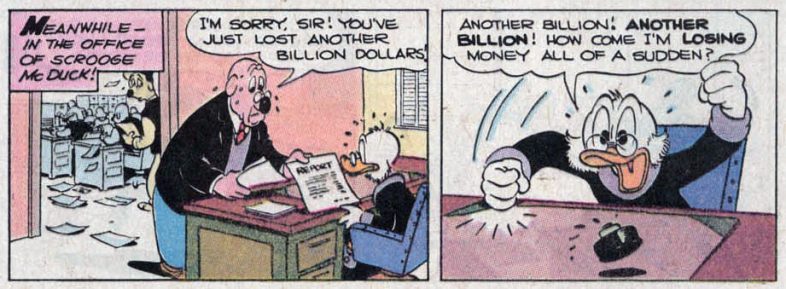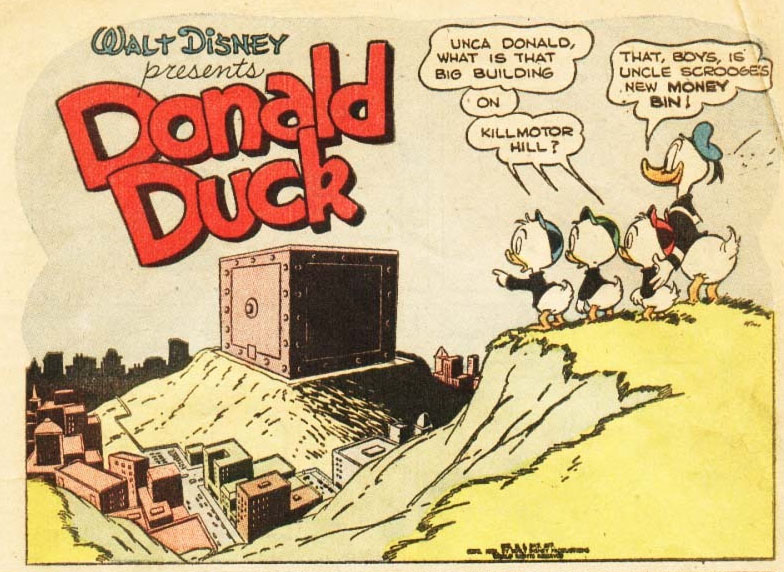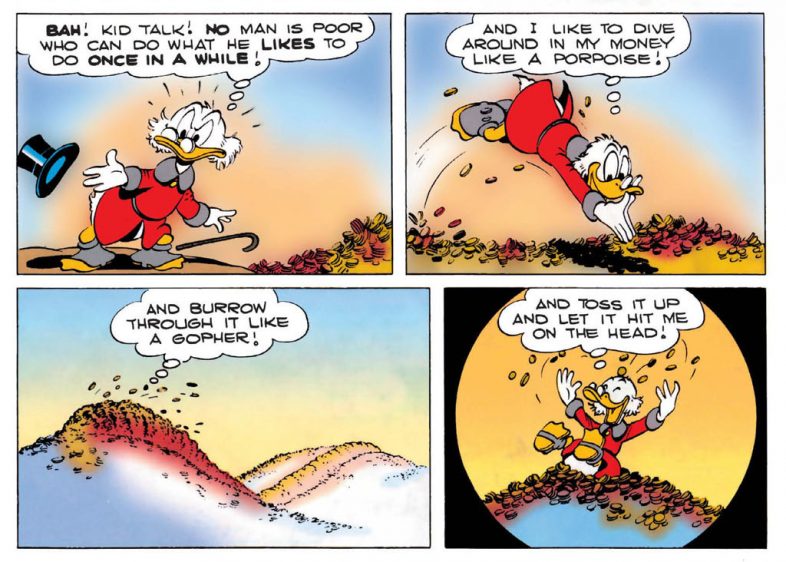How rich is Scrooge McDuck?
By Christopher Gates Posted in Comics, Movies & TV on August 9, 2017 9 min read
DuckTales owes a lot to cartoonist Carl Barks—the Beagle Boys, Magica De Spell, and even ol’ Scrooge McDuck himself all sprung from the imagination of Disney’s “good duck artist.” And yet, of everything that DuckTales borrowed from Barks’ vast body of work, no image is as iconic as Scrooge diving into his massive money bin, swimming through his amassed riches.
But no one knows exactly how much money Scrooge has. In 2013, Forbes Magazine claimed that Scrooge McDuck was the wealthiest fictional character alive. Unfortunately, their estimate of his worth—a paltry $65.4 billion—seems just a little low, and they don’t present any of their research or calculations for fact-checking. The people over at the Billfold used calculus and the average height of a duck to deduce that Scrooge is worth between $31.2 and $210 billion.
And then there’s this detailed analysis from Kinja, which looks at Don Rosa’s blueprints (more on those in a second) and the amount of United States currency in circulation to try and find an answer. Unfortunately, this article doesn’t reach a real conclusion.
It looks like it’s up to us.
Scrooge’s own words

You would think that Scrooge McDuck himself would be the best person (or waterfowl) to answer this question. After all, he’s not shy about calling himself “the richest duck in the world.”
It’s not quite that simple. In the story “Voodoo Hoodoo,” Scrooge tells a story about making his second billion, so we know he has more than that. During “Only a Poor Old Man,” Scrooge says that he’s got both umpteen centrifugillion and umpteen fantasticatillion dollars. In “The Second-Richest Duck” (which introduces Scrooge’s rival, Flintheart Glomgold), Scrooge’s accountant says that Scrooge is worth one multiplujillion, nine obsquatumatillion, six hundred and twenty-three dollars and sixty-two cents.
Unfortunately, those are made up words. This is serious business, and we won’t stand for such foolishness.
In “The Magic Hourglass,” Scrooge loses the secret source of his fortune—a lucky hourglass that makes its owner rich—and starts losing one billion dollars every minute. Distraught, Scrooge laments that, at that rate, he’ll go broke in 600 years.
Now, that’s a great place to start. Given that there are 60 minutes in an hour, 24 hours in a day, and 365 days a year, we can figure out how much money Scrooge is going to lose annually:
1,000,000,000 X 60 x 24 x 365 = $525,600,000,000,000
Multiply that by 600, and you can surmise that Scrooge has roughly $315,360,000,000,000,000.
But wait! There’s more. Assuming that a leap year comes once every four years, there are actually 150 extra days that we need to account for. In addition, this story was written in 1950. Let’s update the total to account for inflation and see how much it’s worth in 2017 (according to the Internet—which you can always trust—$1 in 1950 is worth about $10.23 today)
($315,360,000,000,000,000 + ($60,000,000,000 x 24 x 150)) * 10.23 = $3,228,342,480,000,000,000
That’s over three quintillion dollars, i.e. a lot. On the other hand, Scrooge might be joking—his off-hand comment in “The Magic Hourglass” is pretty clearly a riff on Orson Welles’ classic line from Citizen Kane.
And so, the search continues.
The size of the money bin

There’s one other to deduce the size of Scrooge’s fortune, and that’s by looking at how much cash sits in his money bin. In “A Financial Fable,” Scrooge claims that his money bin (which goes through a few different forms, including a giant safe, before becoming a permanent structure in “The Big Bin on Killmotor Hill”) holds “three cubic acres” of loot.
Once again, however, that’s borderline nonsense—an acre measures area, not volume. Still, there’s hope. Barks’ successor, Don Rosa, provided a floorplan for the money bin in his 2001 story “The Beagle Boys vs. the Money Bin.” According to Rosa, the money bin is a little over 12 stories tall, although it’s not full—the diving board sits at the top of the 10th story, or about 100 feet in the air. That jives with “The Big Bin on Killmotor Hill,” in which Scrooge describes the bin as “ten stories deep and a block square.” In the same story, Donald notes that the bin’s walls and roof are all 10 feet thick in order to foil robbers.
Scrooge doesn’t use all of that space, of course. In “Only a Poor Old Man,” the money bin’s depth gauge shows that it’s only full to the 79-foot marker. That makes Scrooge’s dive about a 21-foot drop, which is well under the 33-foot height of an Olympic diving platform. It’s a big fall, but it’s certainly doable—and Scrooge has had a lot of practice. In “Back to the Klondike,” the depth gauge reads 99 feet.
We’ll average things out and say that Scrooge’s money reaches the 90 foot mark, with the caveat that the amount of cash in the bin probably changes along with Scrooge’s luck. Figuring out the size of the bin’s base is a little more difficult. Rosa’s blueprints imply that the vault’s base is 120 feet by 90 feet (the money bin also has offices, traps, and other luxuries inside, which take up some of the space). Subtract those big walls and you get a money pile that’s 630,000 cubic feet in size.
One problem: 120 by 90 is an awfully small city block. Yes, the size of a block varies by location, but Duckburg is a sprawling metropolis, not a podunk (or poduck?) town. Since we know that Duckburg is located in northern Calisota, which is roughly analogous to California (and we know that Duckburg is north of both Los Angeles and San Francisco), we’ll use Sacramento—the biggest city in that region of California—as our starting point. That gives us a base that’s 410 feet long on each side, with 10-foot-thick walls and a height of 90 feet. Do the math, and you’ll find that the the bin is filled with 13,689,000 cubic feet worth of money.
But what’s inside?

That only solves half of the equation—the easy half. Unfortunately, determining what kind of money sits in the bin is a big, big problem. When the money bin first appears in “The Big Bin on Killmotor Hill,” it seems like it’s filled with primarily with silver coins. Later versions change the coins to gold (or, at least, a gold color), and often add jewels and paper bills to the mix, too.
Complicating things even further, the US Treasury didn’t make any large-denomination silver-colored coins or any gold coins from the 1930s through sometime in the 1970s. Given that Barks was writing and drawing Scrooge’s adventures in the ’40s, ’50s, and ’60s, there’s no telling what’s filling up that bin. It’s probably some kind of weird duck currency, and that doesn’t help us at all.
But since we’ve already come this far, let’s make an assumption: wherever the coins came from, they’re probably made out of gold or silver. Of course, round coins don’t pack neatly into a square space. Air sits between them. Amateur researchers contend that loosely collected coins only have a 55% packing efficiency—i.e. 45% of the space is left empty, thanks to the space between the coins. That makes sense. If the vault was packed solid, Scrooge McDuck wouldn’t be able to go for his daily swim.
The final answers

Thankfully, the density of gold and silver is consistent. A cubic foot contains 1,206 pounds of gold and 655 pounds of silver. Gold coins aren’t usually pure, so we’ll go with the value of 22-karat gold (which is what’s found in the American gold eagles and gold doubloons). By contrast, both silver eagle coins and pieces of eight are 99% pure. That’s close enough to 100% purity for us.
By today’s prices, a pound of 22-karat gold is worth about $16,107, after converting from troy pounds to regular pounds (if you don’t know what that means, eh. Don’t worry about it). A pound of silver is worth about $245.24. In 1950, those amounts would equal $506.22 (sort of—only prices for 24-karat gold seem to be available online) and $105.71 respectively, or $5,136.22 and $1,072.56 after adjusting for inflation.
From here, we can find out a formula that will finally—finally—give us a rough estimate of how much money Scrooge has:
(pounds of material per cubic foot) * (cubic feet of the money bin) * .55 * ($$ per pound)
And so…
If we use Dan Rosa’s dimensions and assume that the coins are gold, then Scrooge has $6,730,777,053,000 today and had $211,538,707,380 in 1950 ($2,146,318,477,380
adjusted for inflation).
If we use our dimensions and assume that the coins are gold, then Scrooge has $146,250,169,965,900 today and had $4,596,433,913,214 in 1950 ($46,636,434,344,214 adjusted for inflation).
If we use Dan Rosa’s dimensions and assume that the coins are silver, then Scrooge has $55,659,057,300 today and had $23,991,677,325 in 1950 ($243,425,536,200 adjusted for inflation).
If we use our dimensions and assume that the coins are silver, then Scrooge has $1,209,391,802,190 today and had $521,304,874,447 in 1950 ($5,289,289,150,860.00 adjusted for inflation).
And if he had a mix of different coins, bills, and gems, and if he has outside investments that contribute to his wealth, and if we want to count things like, say, the totally separate petty cash safe that’s revealed in “Statuesque Spendthrifts,” well… we’ll leave that up to you.